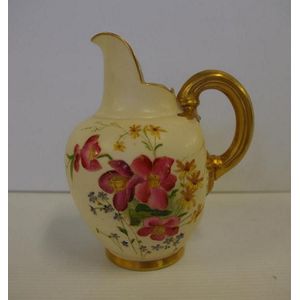Group of Chinese Blue and White Wares
You must be a subscriber, and be logged in to view price and dealer details.
Subscribe Now to view actual auction price for this item
When you subscribe, you have the option of setting the currency in which to display prices to $Au, $US, $NZ or Stg.
- Ewer / Pitcher - A type of jug with a narrow neck bulbous body and wide spout, originally used for carrying and storing liquids such as water or wine. In medieval times they were the source of water to wash ones hands during and after a meal. later the shape was used for vessels in silver, gold, glass and ceramics.
In Victorian times they were made in ceramics and occasionally glass with a matching basin, and sometimes other accessories such as a soap holder or toothbrush holder. Their purpose was to provide facilities for personal washing In the early 19th century were often enclosed in purpose built stands, and later resided on a washstand..
Sometimes the words "ewer" and "pitcher" are used interchangably, but a pitcher is generally considered to be a jug, and would have a wide mouth, and a gently tapering body. - Oviform /ovoid - The outline loosely resembling the shape of an egg.
- Frieze - An architectural term denoting the flat, shaped or convex horizontal surface of furniture, between the architrave and the cornice, usually found on a cabinet or bookcase, or on desks and tables where it may include drawers, the area between the top and the legs. In ceramics, the term refers to the banding, of usually a repeating pattern, on the rims of plates and vases.
- Rustic - Rustic is defined as "of, relating to, or typical of country life or country people", and the items illustrated in this price guide accord with that definition.
But in the 18th and 19th century "rustic furniture" had a narrower definition. It referred to furniture where the framework was carved or moulded to resemble tree trunks and branches, and was usually for outdoor use. Rustic furniture was made in cast iron, wood, terracootta and concrete. Much of the Coalbrookdale company's cast iron furniture was of rustic design.
This item has been included into following indexes:
- Chinese ceramics, decoration - blue and white, other 760
-
Chinese ceramics, item type
- ewers 70
- jugs and ewers 147
- pot pourri and jars 1,315
- tea pots 293
Visually similar items

A Martin Brothers stoneware orchid jug, incised 9-11-82 RW Martin Bros. London & Southall. 21 cm high

Royal Worcester blush ivory jug with handpainted floral decoration, 13 cm high approx.

A European silver plated and cut glass claret jug, late 19th to early 20th century, the baluster form decanter slice cut to the collar with a diamond form frieze above a navette border, the shaped silver neck, hinged spout with foliate finial and ear form

A Royal Worcester blush ivory ewer painted with flowers, 12 cm high
